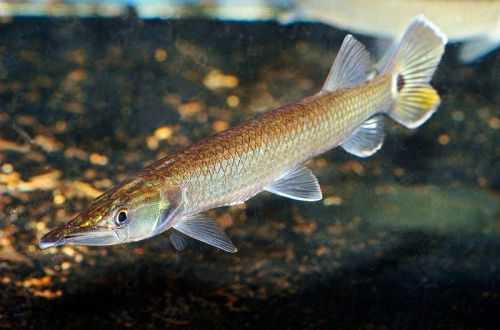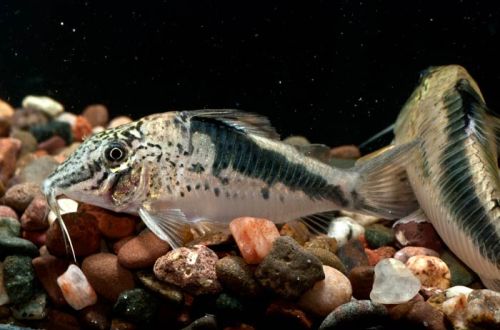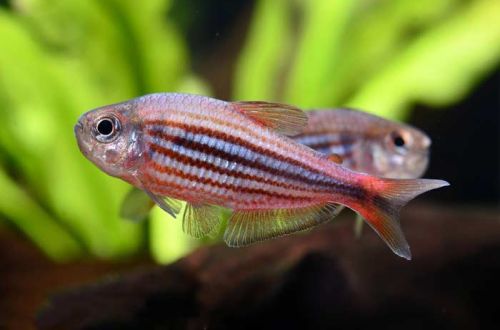
Freshwater Barracuda
Swordmouth or Freshwater Barracuda, scientific name Ctenolucius hujeta, belongs to the Ctenoluciidae family. Efficient and swift predator, despite its way of life quite peaceful and even shy fish, of course the last description is applicable only for species of similar size or larger. All other inhabitants of the aquarium that can fit in the mouth of the Barracuda will be perceived as nothing more than prey.

Loud sounds, impacts on the water and other external influences cause the fish to seek shelter, escape, and in the confined space of the aquarium there is a great danger of serious injury when, when trying to hide, the Barracuda hits the glass of the tank. In this regard, there are problems with the maintenance of the aquarium, cleaning the glass or soil can provoke this behavior – avoid sudden movements.
Habitat
For the first time, a scientific description was given back in 1850, when European researchers discovered it while studying the fauna of colonies in Central and South America. The fish prefer calm waters and are often seen in small groups of 4-5 individuals. During the rainy seasons they swim to flooded areas in search of food, and during the dry season they often remain in small pools or backwaters when the water recedes. In oxygen-depleted water, the Freshwater Barracuda has developed an amazing ability to absorb atmospheric air by capturing it in its mouth. In nature, they hunt in groups, making swift throws from shelters at small fish and insects.
Description
The swordfish has a slender, elongated body with a forked tail fin, as well as a long mouth like a pike, with the upper jaw larger than the lower. On the jaw, peculiar curved “flaps” are noticeable, which are part of the respiratory apparatus. The color of the fish is silvery, however, depending on the angle of incidence of light, it may appear either bluish or golden. A large dark spot is located at the base of the tail, which is a characteristic feature of this species.
Food
Carnivorous species, feeds on other living organisms – fish, insects. It is not allowed to feed mammals (beef, pork) and birds with meat products. The lipids contained in the meat are not absorbed by the Freshwater Barracuda and are deposited as fat. Also, do not serve live fish, they can be infected with parasites.
Until the fish has reached an adult state, you can feed bloodworms, earthworms, chopped shrimp, as soon as they become large enough, you should serve whole shrimp, strips of fish meat, mussels. Feed twice a day with the amount of food eaten in 5 minutes.
Maintenance and care
Fish are sensitive to water quality and produce a lot of waste. In addition to a productive filter (a filter canister is recommended), a part of the water (30-40% of the volume) should be renewed weekly with fresh water. The minimum set of equipment is as follows: filter, aerator, heater, lighting system.
Barracuda lives near the surface and never sinks to the bottom, so the design of the aquarium should not interfere with free movement. No floating plants, only rooting plants in clusters along the side walls. These thickets also serve as a place for shelter. The bottom layer can be customized to your liking as it is of no importance to the fish.
Social behavior
Mecherot is a predator, which automatically reduces the number of neighbors to a minimum, the best option is a species aquarium, or joint keeping with catfish, thus non-intersecting niches of the aquarium will be involved.
Freshwater Barracuda is a peaceful and shy fish, kept either alone or in a group of 3-4 individuals, intraspecific conflicts were not observed.
Breeding / breeding
Not much is known about successful cases of breeding in a home aquarium, this requires special conditions and large reservoirs, as close as possible to natural conditions.
The beginning of spawning is preceded by a courtship procedure, when the male and female swim parallel to each other, then the pair raise the back of the body above the water and release eggs and seeds with a quick movement. This happens every 3–4 minutes, with a gradual increase in the interval to 6–8 minutes. In general, spawning lasts about 3 hours, during which time about 1000 eggs are released. The fry appear during the day, grow very quickly, and if they are poorly fed at this time, they begin to feed on each other.
Diseases
Freshwater Barracuda does not tolerate temperatures below the optimum, which leads to the development of various skin diseases. Otherwise, the fish are hardy and, under favorable conditions, diseases are not a problem. For more information on symptoms and treatments, see the Aquarium Fish Diseases section.





